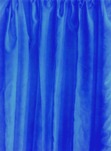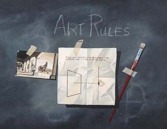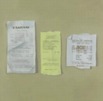|
 trompe l'oeil
- A French term literally meaning "trick the eye."
Sometimes called illusionism, it's a style
of painting which gives the
appearance of three-dimensional,
or photographic realism. It flourished from the
Renaissance onward. The discovery of linear
perspective in fifteenth-century Italy and advancements in
the science of optics in
the seventeenth-century Netherlands enabled artists to render
object and spaces
with eye-fooling exactitude. Both playful and intellectually
serious, trompe artists toy with spectators' seeing to raise questions about the
nature of art
and perception. trompe l'oeil
- A French term literally meaning "trick the eye."
Sometimes called illusionism, it's a style
of painting which gives the
appearance of three-dimensional,
or photographic realism. It flourished from the
Renaissance onward. The discovery of linear
perspective in fifteenth-century Italy and advancements in
the science of optics in
the seventeenth-century Netherlands enabled artists to render
object and spaces
with eye-fooling exactitude. Both playful and intellectually
serious, trompe artists toy with spectators' seeing to raise questions about the
nature of art
and perception.
This story originated in ancient
Greece:
Two painters were rivals in a contest. Each would
try to make a picture that produced a more perfect illusion of
the real world. One, named Zeuxis [ZOO-ziss], painted a likeness of grapes
so natural that birds flew down to peck at them. Then his opponent,
Parrhasius [pahr-HAY-zee-us] brought in his picture covered in a cloth. Reaching
out to lift the curtain, Zeuxis was stunned to discover he had
lost the contest. What had appeared to be a cloth was in reality
his rival's painting.
Examples:

Fra Giovanni da Verona (Italian), Intarsia Illusion of Cupboards, four
panels of wood intarsia,
1520: Each conveys the appearance of open cupboard doors — a
trompe l'oeil effect resulting from the use of linear
perspective. The first
panel: a Campanus sphere,
a mazzocchio, and various instruments of the geometer.
 The second panel:
a complex polyhedron which
can be constructed by erecting a pyramid of equilateral
triangles on each face of an icosidodecahedron. The second panel:
a complex polyhedron which
can be constructed by erecting a pyramid of equilateral
triangles on each face of an icosidodecahedron.
The third: the Campanus sphere again, along with
an icosahedron and a truncated icosahedron.
The fourth:

 Samuel van Hoogstraten (Dutch, 1627-1678),
Trompe-l'oeil,
1664, oil on canvas,
45.5 x 57.5 cm, Dordrechts Museum Samuel van Hoogstraten (Dutch, 1627-1678),
Trompe-l'oeil,
1664, oil on canvas,
45.5 x 57.5 cm, Dordrechts Museum

 Cornelis Gijbrechts (Flemish, c. 1630 - after
1675), Trompe
l'oeil, oil on
canvas, 101.9 x 83.4 cm,
Museum voor Schone Kunsten, Ghent. Cornelis Gijbrechts (Flemish, c. 1630 - after
1675), Trompe
l'oeil, oil on
canvas, 101.9 x 83.4 cm,
Museum voor Schone Kunsten, Ghent.

 Cornelis Gijbrechts, Reverse Side of a Painting, 1670, oil on canvas,
Statens Museum for Kunst, Copenhagen. This type of still life painting was known in 17th
century Holland as a "betriegertje" or little trickster — the vehicle for playing a practical joke. Cornelis Gijbrechts, Reverse Side of a Painting, 1670, oil on canvas,
Statens Museum for Kunst, Copenhagen. This type of still life painting was known in 17th
century Holland as a "betriegertje" or little trickster — the vehicle for playing a practical joke.

 Attributed to J. Deutsch (French, Lorraine),
Plate, 1774, tin-glazed earthenware (faience),
diameter 9 1/2 inches,
Minneapolis Institute of Arts. Attributed to J. Deutsch (French, Lorraine),
Plate, 1774, tin-glazed earthenware (faience),
diameter 9 1/2 inches,
Minneapolis Institute of Arts.

 Pere Borrell del Caso (Spanish, 19th century),
Escaping
Criticism, 1874, oil
on canvas, Banco de España,
Madrid. In advance of art
criticism, this boy (the painting itself) appears to escape
his (its) frame. Pere Borrell del Caso (Spanish, 19th century),
Escaping
Criticism, 1874, oil
on canvas, Banco de España,
Madrid. In advance of art
criticism, this boy (the painting itself) appears to escape
his (its) frame.

 William Michael Harnett (American, born Ireland,
1848-1892), After the Hunt, 1883, oil
on canvas, 52 1/2 x 34
inches, Huntington Library & Art Collections, San Marino,
CA. William Michael Harnett (American, born Ireland,
1848-1892), After the Hunt, 1883, oil
on canvas, 52 1/2 x 34
inches, Huntington Library & Art Collections, San Marino,
CA.

 William Michael Harnett, The Meerschaum Pipe, 1886, oil
on canvas, 17 1/8 x 12
1/8 inches (43.3 x 30.6 cm), Fine Arts Museums of San Francisco,
CA. See bookbinding. William Michael Harnett, The Meerschaum Pipe, 1886, oil
on canvas, 17 1/8 x 12
1/8 inches (43.3 x 30.6 cm), Fine Arts Museums of San Francisco,
CA. See bookbinding.
William Michael Harnett, Still Life with Violin, 1886, oil
on canvas, New Britain
Museum of Art, CT.
Nicholas Alden Brooks (American, 1849 -
c.1904). See counterfeit.
John Frederick Peto (American, 1854-1907),
Book, Mug, Candlestick and Pipe, c. 1880's,
oil on canvas,
12 1/4 x 16 inches, Butler Institute of American Art, Youngstown,
OH.

 John Frederick Peto, Reminiscences of 1865, after 1890, oil on canvas,
30 x 20 inches, Minneapolis Institute of Arts. John Frederick Peto, Reminiscences of 1865, after 1890, oil on canvas,
30 x 20 inches, Minneapolis Institute of Arts.

 John Frederick Peto, Job Lot Cheap, 1892, oil
on canvas, 29 5/8 x 39
3/4 inches (76.2 x 101.7 cm), Fine Arts Museums of San Francisco,
CA. John Frederick Peto, Job Lot Cheap, 1892, oil
on canvas, 29 5/8 x 39
3/4 inches (76.2 x 101.7 cm), Fine Arts Museums of San Francisco,
CA.

 John Frederick Peto, The Cup We All Race 4, c. 1900, oil
on canvas and panel,
25 1/2 x 21 1/2 inches (64.8 x 54.6 cm), Fine Arts Museums of
San Francisco, CA. John Frederick Peto, The Cup We All Race 4, c. 1900, oil
on canvas and panel,
25 1/2 x 21 1/2 inches (64.8 x 54.6 cm), Fine Arts Museums of
San Francisco, CA.
George Cope (American, 1855-1929), Fisherman's Accoutrements, 1887, oil on canvas
on board, 42 x 30 inches (106.68 X 76.20 cm), Butler Institute
of American Art, Youngstown, OH.

 Otis Kaye (American, 1885-1974), One Dollar Note with Quarter and Penny,
graphite and oil
over etching,
2 3/4 x 6 1/2 inches. See counterfeit. Otis Kaye (American, 1885-1974), One Dollar Note with Quarter and Penny,
graphite and oil
over etching,
2 3/4 x 6 1/2 inches. See counterfeit.
Victor Dubreuil (American, active 1886
- c. 1900), The Eye of the Artist, c. 1898, oil
on canvas, 10 x 14 inches
(25.40 x 55.56 cm), Butler Institute of American Art, Youngstown,
OH.
Some pictures drawn by Maurits Cornelis
Escher (Dutch,1898-1972), though monochromatic,
are noted for their high degree of illusionism. Also see optical illusion.
Duane Hanson (American, 1925-). Also see
Photo-Realism.
Paul Sarkisian (1928-).

 Mark Boyle (English, 1934-), Holland Park Avenue Study, 1967, relief, 238.8 x 238.8 x 11.4 cm, Tate
Gallery, London. Mark Boyle (English, 1934-), Holland Park Avenue Study, 1967, relief, 238.8 x 238.8 x 11.4 cm, Tate
Gallery, London.

 Marilyn Anne Levine (American, 1935-), Dark Grey
Satchel, 1974, ceramic,
Arizona State University Art Museum, Tempe. Marilyn Anne Levine (American, 1935-), Dark Grey
Satchel, 1974, ceramic,
Arizona State University Art Museum, Tempe.

 Claudio Bravo (Chilean, 1936-), White Cloth, black conté
on paper, 34.9 x 27.9 cm, 1991
Ubicación Colección Particular. See drapery. Claudio Bravo (Chilean, 1936-), White Cloth, black conté
on paper, 34.9 x 27.9 cm, 1991
Ubicación Colección Particular. See drapery.

 Claudio Bravo, Neptuno (Blue), 1998, lithograph,
image: 30.7 x 23 inches, sheet: 38.2 x 29.5 inches, published
by Marlborough Graphics, NY. This is one in a series of six lithographs,
called "Demi Gods": Venus (Black), Vesta
(Sanguine), Ceres (Sepia), Eros (Red), Neptuno
(Blue), and Flora (Green). This might remind you of the story told above about the painting by Parrhasius. See monochrome. Claudio Bravo, Neptuno (Blue), 1998, lithograph,
image: 30.7 x 23 inches, sheet: 38.2 x 29.5 inches, published
by Marlborough Graphics, NY. This is one in a series of six lithographs,
called "Demi Gods": Venus (Black), Vesta
(Sanguine), Ceres (Sepia), Eros (Red), Neptuno
(Blue), and Flora (Green). This might remind you of the story told above about the painting by Parrhasius. See monochrome.
William T. Wiley (American, 1937-).

 David Brega (American, 1948-), Colors, 1999-2000, oil
on Masonite, 67 x 50
inches, Kemper Museum of Contemporary Art, Kansas City MO. David Brega (American, 1948-), Colors, 1999-2000, oil
on Masonite, 67 x 50
inches, Kemper Museum of Contemporary Art, Kansas City MO.
Richard Newman (American, 1948-).

 Larry Charles (American, 1951-), Art Rules, oil
on panel, 16 x 20 inches, private
collection. Larry Charles (American, 1951-), Art Rules, oil
on panel, 16 x 20 inches, private
collection.

 Molly Springfield (American, 1977-), Matchbooks,
2001, oil on paper,
29 x 5.5 inches, collection of the artist. See ephemera
and philluminist. Molly Springfield (American, 1977-), Matchbooks,
2001, oil on paper,
29 x 5.5 inches, collection of the artist. See ephemera
and philluminist.

 Molly Springfield, Three Receipts, 2002, oil
on board, 12 x 12 inches, collection of the artist. Molly Springfield, Three Receipts, 2002, oil
on board, 12 x 12 inches, collection of the artist.
When trompe l'oeil refers to
a sculpture, it is one made
so much like its subject
that it might fool the viewer into thinking that it is the original subject. Sculptures
by Americans Duane Hansen (1925-) and John DeAndrea (1941-) are
painted casts
made from models
to which real body hair are attached, Hansen adding real clothing
and props.

Also see anamorphosis,
ephemera, faux,
marbling, optical
illusion, perspective,
Photo-Realism, and still
life.
|
